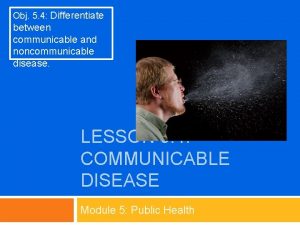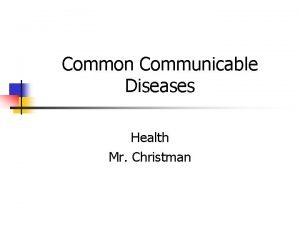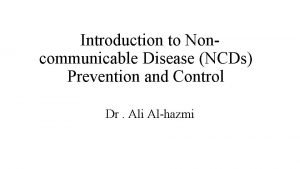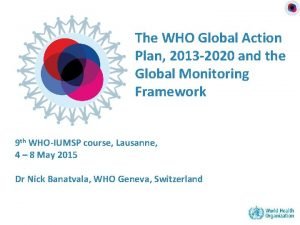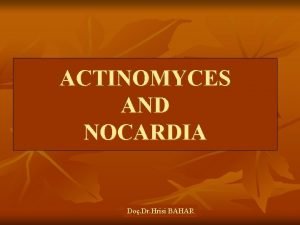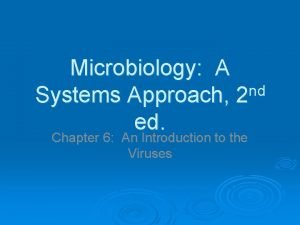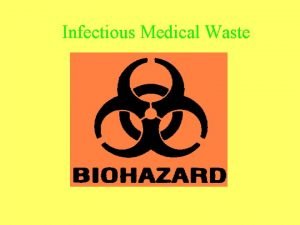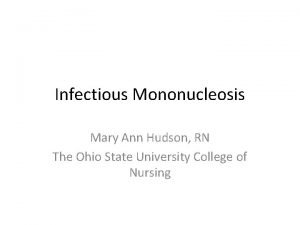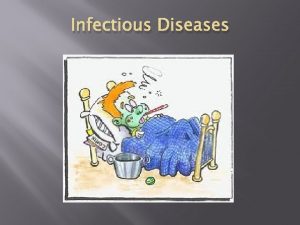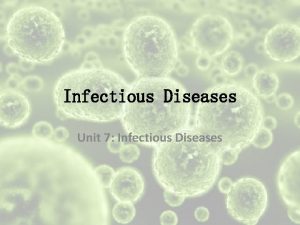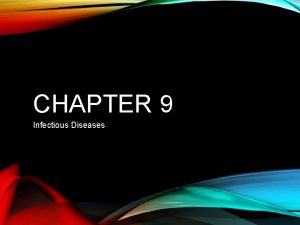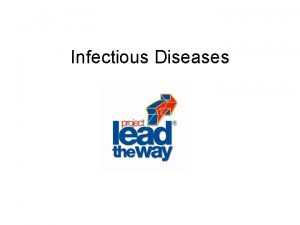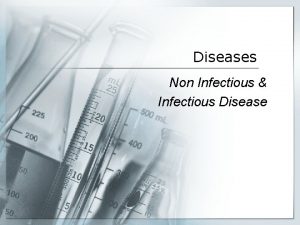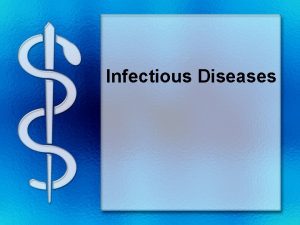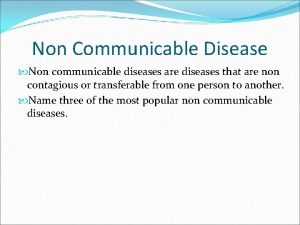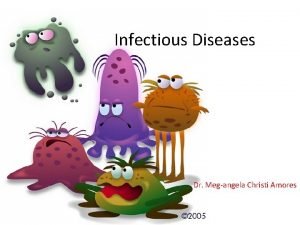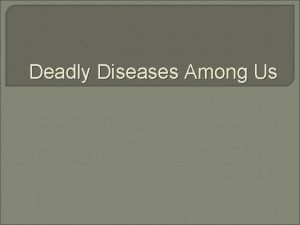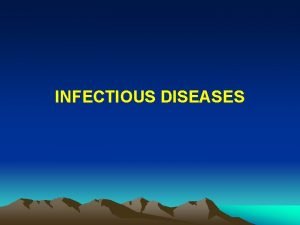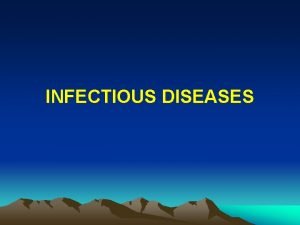Infectious Non Infectious Diseases Infectious Diseases Infectious diseases




















- Slides: 20

Infectious & Non -Infectious Diseases

Infectious Diseases Infectious diseases are caused by pathogenic microorganisms, such as bacteria, viruses, parasites or fungi; the diseases can be spread, directly or indirectly, from one person to another. How Infections Occur

Methods of Transmission Droplet Contact Also known as the respiratory route, it is a typical mode of transmission among many infectious agents. If an infected person coughs or sneezes on another person the microorganisms, suspended in warm, moist droplets, may enter the body through the nose, mouth or eye surfaces. Diseases that are commonly spread by coughing or sneezing include (at least):

Fecal – Oral Transmission Direct contact is rare in this route, for humans at least. More common are the indirect routes; foodstuffs or water become contaminated (by people not washing their hands before preparing food, or untreated sewage being released into a drinking water supply) and the people who eat and drink them become infected. In developing countries most sewage is discharged into the environment or on cropland as of 2006; even in developed countries there are periodic system failures resulting in a sanitary sewer overflow. This is the typical mode of transmission for the infectious agents of (at least): Cholera Hepatitis A Polio Rotavirus Salmonella

Sexual Transmission This refers to any disease that can be caught during sexual activity with another person, including vaginal or anal sex or (less commonly) through oral sex. Transmission is either directly between surfaces in contact during intercourse (the usual route for bacterial infections and those infections causing sores) or from secretions (semen or the fluid secreted by the excited female) which carry infectious agents that get into the partner's blood stream through tiny tears in the penis, vagina or rectum (this is a more usual route for viruses). Some diseases transmissible by the sexual route include (at least): HIV/AIDS Chlamydia Genital warts Gonorrhea Hepatitis B Syphilis Herpes

Transmission by Direct Contact Diseases that can be transmitted by direct contact are called contagious. These diseases can also be transmitted by sharing a towel (where the towel is rubbed vigorously on both bodies) or items of clothing in close contact with the body (socks, for example) if they are not washed thoroughly between uses. For this reason, contagious diseases often break out in schools, where towels are shared and personal items of clothing accidentally swapped in the changing rooms. Some diseases that are transmissible by direct contact include: Athlete's foot Impetigo Syphilis (on rare occasions, if an uninfected person touches a chancre) Warts

Vector Borne Transmission A vector is an organism that does not cause disease itself but that transmits infection by conveying pathogens from one host to another. Examples include mosquitoes, deer ticks, animal bites, etc.

Test Your Knowledge! Is It Contagious?

Non – Infectious Disease Non-infectious diseases (also called Non- communicable diseases ) are those diseases that are not caused by a pathogen and cannot be shared from one person to another. Non-infectious diseases may be caused by either the environment, nutritional deficiencies, lifestyle choices, or genetic inheritances. Unlike infectious diseases, noninfectious diseases are not communicable or contagious, although some kinds can be passed down genetically to the children of a carrier.

Infectious vs. Non-Infectious Historically, infectious diseases were the main cause of death in the world and, indeed, in some developing regions this may still be the case. With the development of antibiotics and vaccination programs, infectious disease is no longer the leading cause of death in the western world. Non-infectious disease is now responsible for the leading causes of death in both developed and some developing countries.

Causes of Non-Infectious Disease Causes of non-infectious disease are categorized into genetically inherited diseases and environmental diseases. Non-infectious diseases that are not genetic disorders are environmental diseases, although many diseases are affected by both genetic and environmental factors.

Inherited Diseases Genetic disorders are caused by errors in genetic information that produce diseases in the affected people. These errors may include: A change in the chromosome numbers, such as Down syndrome A defect in a single gene caused by mutation, such as Cystic Fibrosis.

Environmental Diseases Environmental disease is a very broad category. It includes avoidable and unavoidable conditions caused by external factors, such as sunlight, food, pollution, and lifestyle choices. The diseases of affluence are non-infectious diseases with environmental causes. Examples include: Many types of cardiovascular disease Chronic obstructive pulmonary disease caused by smoking tobacco Type 2 Diabetes Malnutrition caused by too little food, or eating the wrong kinds of food (e. g. scurvy from lack of Vitamin C) Skin cancer caused by radiation from the sun

Cancer is a non-infectious disease that affects millions of people. The National Cancer Institute reports the most common cancer type as nonmelanoma skin cancer, with about one million cases a year. Lung cancer is the secondmost common, with about 219, 440 new cases and 159, 390 deaths. Other common cancers include bladder, breast, leukemia, pancreatic, prostate, thyroid, colorectal, endometrial and kidney cancer.

Heart Disease Mayo Clinic reports heart disease, a non- infectious disease, as the number-one killer in the United States. Heart or cardiovascular disease refers to a variety of conditions that involve the circulatory system. Heart attacks, strokes, chest pain, tachycardia, high cholesterol, heart valve disease, high blood pressure, palpitations and congenital heart disease are some of the non-infectious heart diseases.

Kidney Disease The National Kidney Foundation reports chronic kidney disease (CKD) is a non-infectious disease that affects about 26 million Americans. CKD results when the kidneys are no longer able to remove wastes from the body. Diseases such as diabetes, high blood pressure, lupus, kidney stones and polycystic kidney disease may hinder the kidneys' ability to process and remove wastes.

Mental Disease Mental disease covers a broad range of non-infectious diseases that affects people of all ages. Autism, panic attacks, narcolepsy, manic-depressive disorder, depression, bulimia nervosa, bipolar disorder and Asperger's syndrome are examples of non-infectious mental diseases.

Bone Disease Non-infectious bone diseases include osteoporosis, Paget's disease and osteogenesis imperfecta. Osteoporosis indicates a low bone mass, fragile bones, and high risk of bone fractures. Paget's disease presents as bones that grow larger and weaker than normal bones. Osteogenesis imperfecta (OI) is a non-infectious genetic disorder. OI symptoms include bones that break easily.

Muscle & Joint Disease Non-infectious muscle and joint diseases include fibromyalgia, rheumatoid arthritis and gout. Fibromyalgia is a chronic non-infectious disease identified as pain and tender points in soft tissue, muscles and joints throughout the body. Merck Manual, an online medical library, reports rheumatoid arthritis (RA) affects about one percent of the world's population. RA symptoms range from mild occasional joint pain to severe and debilitating pain. Gout is a non -infectious disease caused by high levels of uric acid in the joints and manifests as sudden severe joint pain, possibly accompanied by fever and feeling ill.

Diabetes When carbohydrates are eaten, they get converted to glucose which is blood sugar. To stabilize blood sugar levels, the pancreas releases insulin. In people that have diabetes, a noninfectious disease, the pancreas does not release insulin properly or at all in the most severe cases. This can cause kidney failure, blindness, nerve damage and heart problems.
 Icd 10 morbus hansen
Icd 10 morbus hansen Emerging infectious diseases
Emerging infectious diseases Je sers un sauveur tendre
Je sers un sauveur tendre Venn diagram of communicable and non-communicable diseases
Venn diagram of communicable and non-communicable diseases Non communicable diseases
Non communicable diseases Venn diagram of communicable and non-communicable diseases
Venn diagram of communicable and non-communicable diseases Non common communicable diseases
Non common communicable diseases Myth and fallacies about non-communicable diseases
Myth and fallacies about non-communicable diseases Non communicable diseases infographic
Non communicable diseases infographic Venn diagram of communicable and noncommunicable diseases
Venn diagram of communicable and noncommunicable diseases Infectious disease
Infectious disease Chapter 26 infectious disease prevention and control
Chapter 26 infectious disease prevention and control Noncellular infectious protein particles are called
Noncellular infectious protein particles are called Infectious canine hepatitis in dogs
Infectious canine hepatitis in dogs Infectious waste definition
Infectious waste definition Infectious mononucleosis
Infectious mononucleosis Infectious canine hepatitis in dogs
Infectious canine hepatitis in dogs Stages of infectious disease
Stages of infectious disease Infectious stunting syndrome
Infectious stunting syndrome Infectious nucleic acid
Infectious nucleic acid Infectious disease quality controls
Infectious disease quality controls





